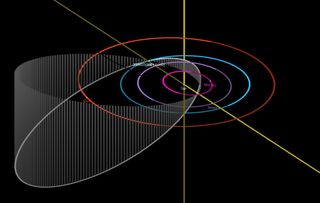The largest asteroid of the year will swing by Earth on Sunday. But don't worry.
The asteroid "2001FO32," is big, it's fast, but it poses no danger to Earth.

The largest asteroid to come near our planet this year will swing by Sunday (March 21), giving astronomers a rare opportunity to glimpse a remnant from the birth of our solar system, astronomers say.
The so-called "2001FO32" is big; it's fast; and in astronomical terms, it swings by quite "near" our delicate planet, earning it the title of "potentially hazardous asteroid." But 2001FO32, first discovered in 2001, has a well-known orbit and poses no danger to Earth.
At its closest encounter with our blue orb, the space rock will still be a whopping 1.25 million miles (2 million kilometers) away, about the distance you would travel if you flew 50 times around the globe. "There is no chance the asteroid will get any closer to Earth than 1.25 million miles," Paul Chodas, the director of NASA’s Jet Propulsion Laboratory's Center for Near Earth Object Studies, said in a NASA statement. That means, there's no need to worry about an imminent collision; in fact, there's no need to worry about it for centuries to come, NASA said.
Related: In Photos: The impact craters of North America
2001FO32 is estimated to be somewhere between 1,300 and 2,230 feet (440 and 680 meters) wide, but when it was first discovered in 2001, scientists thought it was about 3,000 feet (1 km) wide. The upcoming close encounter will allow scientists a chance to better measure the beast.
This close encounter will allow astronomers to not only get a better understanding of the asteroid's size but also figure out its makeup. With NASA's Infrared Telescope Facility on top of Hawaii's Mauna Kea, for example, astronomers hope to measure how light reflects off the asteroid's surface to figure out what minerals it's made of.
What's more, researchers also hope to bounce radar signals off of the asteroid using dish antennas from NASA's Deep Space Network to better understand its size and rotation rate, and to potentially discover surface features or small satellites (for example, a small moon).
Sign up for the Live Science daily newsletter now
Get the world’s most fascinating discoveries delivered straight to your inbox.
Due to its highly elongated and inclined orbit around the sun — which boosts the space rock’s speed in the inner solar system and slow it down in deep space — 2001FO32 will be traveling faster than most asteroids when it swings by our planet, at about 77,000 mph (124,000 km/h).
On Sunday, the fast-moving asteroid will make its closest approach to the planet at 12:03 p.m. EDT (1603 GMT), Live Science previously reported. But the 2001FO32 encounter won't only be visible to experts; amateur astronomers can glimpse the asteroid as well.
"The asteroid will be brightest while it moves through southern skies,” Chodas said in the statement. "Amateur astronomers in the Southern Hemisphere and at low northern latitudes should be able to see this asteroid using moderate size telescopes with apertures of at least 8 inches in the nights leading up to closest approach, but they will probably need star charts to find it.”
You can also watch it live online on The Virtual Telescope Project website.
If you miss it, well, you'll have to wait another three decades; the next time this giant rock pays such a close visit will be in 2052, when it swings by about 1.75 million miles (2.8 million km) away.
Originally published on Live Science.

Yasemin is a staff writer at Live Science, covering health, neuroscience and biology. Her work has appeared in Scientific American, Science and the San Jose Mercury News. She has a bachelor's degree in biomedical engineering from the University of Connecticut and a graduate certificate in science communication from the University of California, Santa Cruz.
